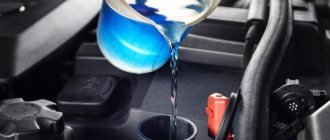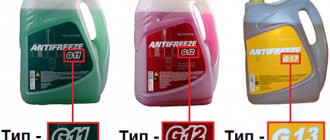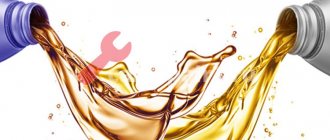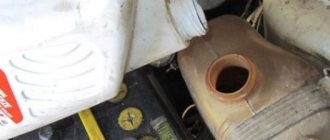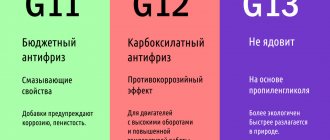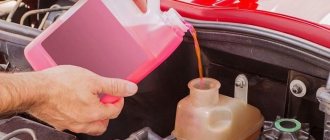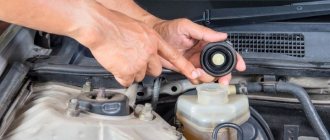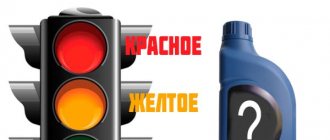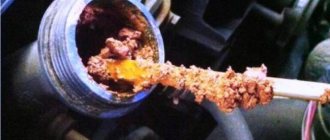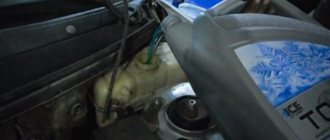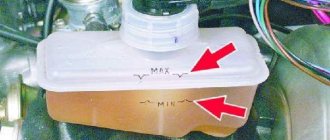What happens if you mix several types of antifreeze from different brands? Is it possible to mix them with each other at all? What does this mean? What is the difference between blue antifreeze and red? We will try to cover these and other questions in this article so that the reader has a comprehensive answer and does not engage in “alchemy”, mocking his vehicle in the process.
Let’s say right away that it is possible to mix antifreeze of different brands if certain conditions are strictly observed. In other cases, you are almost guaranteed to ruin the radiator within a couple of years. In most cases it will be impossible to recover. Therefore, think three times before subjecting your vehicle to various tests.
What does antifreeze consist of?
Let's start with an educational program on the chemical composition. 80% of any coolant is a combination of distilled water and ethylene glycol. This formula is typical for the G11 and G12 standards. The remaining 20% (on average) comes from additives, which characterize this or that antifreeze.
Additives are a key aspect of the composition . They are added to eliminate the destructive ability of water and ethylene glycol on the metal components of the vehicle's cooling system, especially the radiator walls and tubes. Roughly speaking, there are only 2 types of additives:
- protective - protect pipes and other elements, creating a thin film on the walls of components. Used in antifreeze and G11 compounds;
- anti-corrosion - eliminate any type of rust during operation, or slow down such processes as much as possible. Such additives are typical for G12 and G12+.
There are also hybrid additives, separated into a separate composition G13. They combine chemical elements of the first and second categories in the correct proportions. That is why this category is considered universal and is suitable for “topping up”, but not in all cases.
Composition of G12 fluid
- Ethylene glycol 90%, necessary for frost protection.
- The dye is usually red, but there are exceptions.
- Distilled water 5%.
- A set of additives 5%, serves to protect non-ferrous engine metals from ethylene glycol. This liquid has carboxylate additives consisting of organic acids. They are inhibitors that make it possible to neutralize the negative effects of ethylene glycol. Antifreezes with different sets of additives function differently. Their main difference is the way they deal with rust.
In addition to these additives, the package includes additives with other characteristics. For example, the liquid must have anti-foaming properties, lubricating compounds that prevent the occurrence of scale.
Color characteristics
Antifreeze of different colors was originally developed to work with a specific group of metals. At the moment this is not important, although previously car manufacturers tried to introduce this gradation by offering recommended “dyes” for the compositions. Currently the categories are as follows:
- G11 – green, blue and variations;
- G12 – yellow and red, poisonous orange;
- G13 – purple.
This is all theory. In practice, many manufacturers color antifreeze as they please, since there is no strict standardization. So G11 has a “spread” from blue to crimson, G12 can be green, and G13 can be completely yellow. The result is confusion and it becomes increasingly difficult for the car owner to navigate the differences in composition and their purpose.
What happens when you mix different colors?
Hands down, nothing will happen if you mix formulations from different manufacturers, although there are certain conditions. Situations can be different, including force majeure, so read the ingredients first. If green G11 is mixed with green, but from a different manufacturer, with the most similar parameters, the engine will not be damaged. This also applies to other standards. Only coolant products of the same color and additives can be mixed with each other.
Now about the “traffic light”. As mentioned above, the same G11/12/13 can have a wide palette of shades. Antifreeze of different colors with an identical formula will interact perfectly with each other . The main headache for motorists is the G13 in purple and yellow. Many are afraid that they are completely different, although this is fundamentally false. Let's start with the fact that this antifreeze is universal in nature and has a double portion of additives that get along with each other without any special consequences. You will just get a new shade, nothing more.
What are the differences between the G11 and G12 series antifreezes?
Inorganic (they can also be called glycol) antifreezes for the G11 series engine contain special additives and numerous inhibitors against corrosion.
These inhibitors create a so-called protective film near the very surface of the motor elements. Additives of this type should be used if automotive antifreeze comes into dangerous contact with the surface of non-ferrous metal. These metals do not have a protective coating and can break down quite quickly under the aggressive influence of glycol.
Coolant mixtures of the G11 level can be produced within several months and require replacement almost immediately.
- Antifreeze G11 - it is worth considering that this antifreeze usually has a green tint. The prototype of almost every cooling mixture for a car on the market is a product labeled G11, created, as previously mentioned, by Volkswagen. Currently, the company's products under the G11 brand are, to put it more frankly, hybrid antifreeze systems that were manufactured based on specification 774C.
- Other manufacturers also use this marking, but they often do not comply with the established specification standards. For example, the so-called Volkswagen antifreeze 774 series contains practically no borates and amines, it also has almost no phosphates when compared with the newer G12 and has silicates in minimal quantities. Antifreezes that are “traditional” in their structure, which come with the designation G11, also contain these substances.
- Antifreezes of the G12 series can be safely classified as carboxylate mixtures. Once upon a time, exactly the same company made coolant G12 antifreeze, after which it created its own separate specification called VW TL.
- With the active use of the mixture for cooling the G12 level, a completely different mechanism is created for protecting the car engine than with the G11 series antifreeze. The insides of the engines of new types of machines were made without brass and other metals, only from aluminum.
Is it possible to mix different standards?
Here the situation is more interesting. If antifreeze of different colors, but of the same group, can be interchanged, then different products can cause unexpected reactions in the system, only aggravating the situation of your radiator and other components of the cooling system.
Is it possible to mix antifreeze of different subgroups? You need to understand that G11 and G12 have completely different additives: the former are aimed at creating a film, the latter at eliminating rust. It is almost impossible to control the mixing of active components. Yes, sediment may not fall, but the film will significantly reduce the cooling efficiency. This is because green antifreezes reduce the diameter of pipes and other components. The temperature drops, as do the cooler characteristics. A kind of “thrombus” may even form, which can cause the radiator to fail.
It all depends on the final volume of the diluent liquid. If you pour up to half a liter, then there will be no consequences. But in the future you need to fill in the “native” cooler.
How to check compatibility
If you wish, you can check the compatibility of the coolant yourself in “garage” conditions.
Antifreeze mixing
This method is comparable to testing for an allergic reaction. You need to take a sample of the liquid poured into the system and a sample of the one you plan to add. Next, mix them in equal proportions and monitor the reaction. If after 5-10 minutes a reaction occurs, the color changes to brown, a precipitate forms or foam appears, then this indicates incompatibility of the samples. There is no way to mix them. If everything proceeds calmly, then the liquids can be diluted. To be sure, it is best to additionally heat the mixture to an operating temperature of 80-90°C.
You need to mix antifreeze, as they say, “wisely.” It is best to avoid such situations altogether and fill only with recommended fluids. If such a situation occurs, then you need to mix some classes, and not just colors, since color does not always indicate composition or category. For example, the Japanese use color to highlight a liquid’s resistance to frost.
The consequences of mixing yellow and green
We have already found out whether it is possible to add antifreeze of the same brand and what the consequences are, but is it possible to mix red (green) and yellow antifreeze? But here the consequences will be dire.
Green (also known as red and blue) is a coolant based on ethylene glycol and distilled water. The yellow (purple) liquid consists of propylene glycol, and this is a significant difference. Is it possible to mix these antifreezes? Absolutely not.
Ethylene and propylene are different types of alcohol, albeit monohydric. Another thing is that the first one is toxic, and in the second case this flaw was removed. Let's add 2 types of additives to G13. We get the following picture:
- we have no idea how alcohols react with each other and how dire the consequences are;
- the additives in G13 are designed specifically for propylene glycol, so no one can say how they will behave in “foreign” elements;
- no one will give a confident answer about the compatibility of antifreeze.
Remember that the universal donor is not G13, but G12++. It is written above in detail which antifreezes can be mixed without consequences.
Read the composition of the product very carefully and never skimp on coolant. Car repairs will still cost more, especially major ones. Not the smartest way to keep money in your wallet.
Item matters
If we discard antifreezes (which also have differences), the buyer’s choice is narrowed down to three main options:
G11 – ethylene glycol group, with a limited package of additives. Economical option, color identification: green. Covers the entire internal surface with an anti-corrosion layer, which impairs heat transfer. Used in low-power engines with low maximum speeds.
G12 – ethylene glycol and carboxylate are used as antifreeze. Distinctive feature: protection against corrosion does not occur on the entire surface, but only in the necessary places. Thanks to this, heat dissipation from metal parts is improved. This antifreeze is quite expensive, but it can be used in engines with high thermal load. Color – red.
G13 – antifreeze based on polypropylene glycol. The characteristics differ little from the previous composition and have minimal impact on the environment.
The composition is expensive, so it is in low demand among car owners of used cars. G13 color is yellow, orange, or purple: depending on the type of additives and manufacturer.
Important: Color coding may not comply with generally accepted standards. Manufacturers sometimes use the dye not to identify the class, but as an advertisement for their product.
When choosing, it is not so important what color the antifreeze is. The main thing is the class (G13 or another), as well as a message on the label which additive is used as an antifreeze.
Car owners are better known for VAG G13 antifreeze, thanks to a wide range of cars. Volkswagen AG purple antifreeze is poured into engines of AUDI, SEAT, Skoda, and Volkswagen itself. In addition to the generally accepted standard, there is a car manufacturer marking: G 013 A8J M1.
Yellow G13 antifreeze is produced by third-party manufacturers; VW does not recommend pouring it into its cars.
Results
The confusion about the colors of antifreeze and antifreeze infuriates any motorist. During the 2 years that the cooler is in operation and the driver does not bother replacing it, resilient manufacturers come up with new standards and variations of their products, which only plays into the hands of marketers, but not the consumer. You also can’t stock up on coolant for future use due to the limited shelf life. Try to choose one manufacturer, find an intelligent seller who will explain in detail what the difference between the compositions is. And you yourself will learn to read the list of ingredients in order to significantly save on the service in the future.
